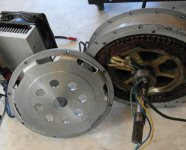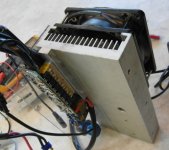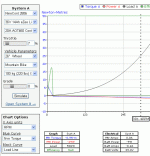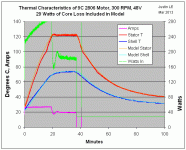John in CR said:
justin_le said:
You'll notice in the picture that the hub side covers are painted flat black with BBQ paint, which should also has a high emissivity.
A good BBQ paint will have low emissivity if the company chemists have come up with a good formulation, because they want to keep the heat in not purposefully radiate it away. Highly emissivity is a double edged sword usually, because it's almost always has high absorptivity too, so that 37W doesn't consider how much it absorbs. Plus while parked in the sun it can directly cause a warm motor to start.
High emissivity/low absorption is what you want on the outside, and anodized aluminum is one of the few things that fits that bill, though I'm not up on what color(s) are best. On the inside you need low emissivity and high absorption, and that's tough too, but I remember while researching the collector for a solar hot air engine that there is one flat black BBQ paint making that claim. I can't remember the brand, but all that stuff was on a crashed hard drive and the backup was reformatted once solar panels became so cheap that LTD solar engines made no sense other than as novelties.
Get good ventilation going and the covers won't be very warm anyway. For a sealed motor with no oil, sure do everything you can if you have heat problems.
More efficient motors and properly sized motors are better answers, and if you have to suffer with the poor efficiency of common motors then don't over-drive them. Most heat problems are the result of improper settings on the controller. The most common is a phase/battery current limit ratio that is way too high, which is also a major cause of blown controllers. I realize these are OT, but it's high time these explanations come from the top. Add to the list the helpful hint that stop-n-go traffic is the most torturous condition on a hubmotor since each repetitive start from zero begins at 0% efficiency and how easy you are on the throttle makes little difference. If you're worried about heat get the bike started with the pedals.
Cooling is a great topic. Just lets not forget about reducing the heat generated in the first place.
I agree with everything in this mildly off-topic approach, and I personally think the folks with overheating problems driving 10-15x the motor design current into a hubmotor so that the system only works because the usage duty cycle is so low are kinda being silly about things, when an electric vehicle can deliver that thrilling performance/riding-experience you want all the time in a way closer to stable way if the stator was grown in radius a inch and/or grown in width another inch or so in whatever hubmotor you're using right now (possible exceptions to guys with a small handful of the very large yet also well designed hubmotor offerings out there). The penalty is like maybe 5lbs if it's designed right using light strong methods, and you just pretty much end cooling issues entirely once you've got a properly sized large electric motor for the task. For my roadbike that I'm setting up just a 200w assist (just enough to help my road-bike-fun-and-exercise rides stay-up with good in-shape riders if I pedal hard on), this means my cute 350w motor might be dragging around more weight than I need even though it's gotta be in the same weight range of the smallest made I think. Yet, on the other end of the spectrum, even the x5304 I used on an early gen of deathbike raced at the Tuscon deathrace wasn't nearly big enough to handle the 400amp 120v setup I was hitting it with. It just melted down in 3 laps in a smoking mess of disappointment, yet in Arlo's BMX, the exact same type of motor delivered a thrilling overly-wheelie-prone experience that was like the ultimate cross-town short wheel base maneuverable hard accelerating vehicle to rip through traffic with an it had no cooling issues at all in this usage model, so being larger would just be more weight for nothing but a tiny bit more range perhaps from efficiency improvements, but overall not worth the extra 5lbs to carry.
It's crazy the motor size thing. Rather than different brands of roughly the same size motor, I would love to see more branching out into the un-charted spaces for bicycle hubmotors. If you want something with magic pie diameter and 75mm width or whatever, because you want to spend most of your time cruising a 60mph on the highway hauling a utility trailer or something on your bicycle, a motor that does that easily and efficiently should exist. Likewise, if I want to just have 200w of help on my otherwise feather-light roadbike as just a mild edge to let me ride with my in-shape roadbiker friends without holding them up, I want a motor that's thermal limit is not much higher than being able to supply 200w of assist steadily without overheating, and have it be made with as much consideration to weight savings and quality as my dura-ace and ultegra components were given on the rest of the bike. I might be one of the few DIY electric bicycle conversions that has more money in the pedal drivetrain parts than the whole electric conversion expenses, and I'm wishing the motor was smaller. lol

I think the available stuff isn't too far off the mark, things like the ebike classic hubs we run here are honestly pretty much in the right size scale for typical sane bicycle transportation uses. I just want to see the other ends of the spectrum also get supported better, the extremely high continuous torque efficient and still drops-in-a-bicycle-frame space, and the so tiny an light of a thin direct drive motor that nobody who wanted to fully power a bicycle without pedaling it would never even find it a useful amount of assist. Like a motor so small it's continous thermal limit is say 100w output, yet it's silent and super light and still efficient from growing a big very thing radius using spoked side covers or something to keep it extremely light while still having like a 5mm thick large diameter stator supported by some super light interior truss work structure connecting to the hub axle. This is totally on the level that is reasonable to make for exotic weight savings on roadbike parts that only shave like 25grams off the next step down part that costs $300 less, and does everything functionally just as well and will likely last longer, it's only crime is being 25grams heavier, and that's why the ultra premium weight savings parts exist. Riding a super super light roadbike is fun, feeling it surge forward with every pedal stroke fun, I would pay $1000 for a deeply well designed leveraging premium materials to be strong and light and efficient hubmotor that only outputs 100w continous for my roadbike, but it's too little power to interest most folks into bothering to make. Likewise, if I wanted to be a bicycle based large package courier or something, I might want a 4x width bigger radius than magic pie motor on my bike, so I can haul a refrigerator home on a trailer or whatever up hills at normal safe traffic speeds, and the rest of the time I just pay a stiff weight and no-load efficiency penalty on my efficiency while riding around unloaded and not requiring my motor to be so large. Maybe even have a second bicycle with a tiny roadbike hub for transportation when it's just yourself and you feel like exercise, and the huge motor bike sits until the person needs to haul a heavy item again or something. Like owning a pickup and an efficient sports car. Both can be very fast and fun, both can badly do the jobs of each other if you could only own one or the other, but rather than needing all the hassles of owning two full registered insured vehicles that need expensive maintenance etc, you just have a pair of bicycles that store easily in a small space in your hall way. Way lower footprint. Eliminating any restrictions on bicycle motor power levels would be a good start. That may be why this cooling concern is always a lingering issue in many high performance ebike applications. Some fools made 'laws' and suppliers put effort into product development that fits in those cruide guidelines rather than making what makes the most sense for the application.
Ok. So, back to cooling what we've got available, which does make fun and often thrilling to ride quick light ebikes, and should give them the ability to handle those 10x design power bursts for even longer duration and more frequent use, which is definitely something worth doing and conclusively finding what surface and what heat transfer methodology does perform the best.
Something I'm curious to know, is the simple equilibrium temp difference on the outside of the case at full speed no-load of a direct drive hubmotor just free-spinning in stagnant air around it for an hour or whatever to reach the practical thermal limit approaching equilibrium vs filled 1/3rd of the way up with ATF oil. I have a hunch the additional internal fluid friction making perhaps a substantial amount more heat from the higher full-speed no-load current, and the reduction in delta-T between stator and case, I imagine the no-load approaching equilibrium limit temp will be something surprising, like +20degC higher no-load ~equilibrium temp. However, I then also wouldn't be suprised to see it capable of handling 1.5->2x the continuous power out across the speed range despite starting with a no-load temp offset of 20degC. That outer case is going to get so hot on that oil filled one, it might be able to reach flesh-searing hot while the insides are still all operating at a safe temp. That lets a motor shed heat very effectively through both radiation and conduction from a higher ambient to case temp delta.








